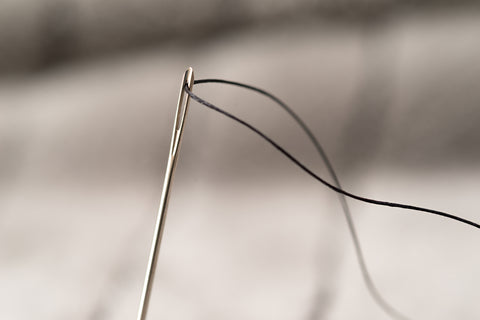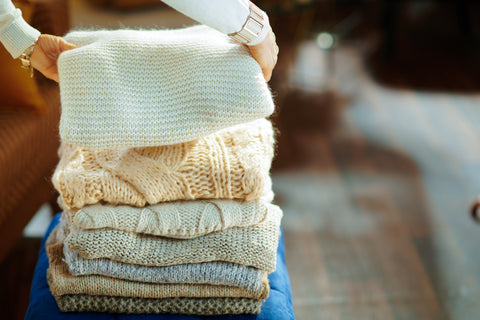
Caring for Knits (Psst... stop hanging your sweaters!)
Share
Every spring, the weather inevitably warms up and the winter woolies get put away until next fall. It’s easy to quickly push them to the back of the closet and pull out the shorts, but taking the time to put them away properly will go a long way towards preventing damage.
As knitters, we know how much effort goes into making garments, so we’re generally pretty careful when wearing them. But a lot of damage occurs in storage, not in wearing. Moths and other insects are particularly drawn to soiled areas of garments and will happily spend their active summer months munching away on your favorite sweater!
I like to spend a leisurely afternoon getting all of my sweaters in order before storing them for the summer. Here’s my easy four-step process for ensuring that I don’t find any nasty surprises when I’m ready to wear them again in the fall:
Step 1: Inspection

Carefully examine your knits in good light, looking for damage and dirt. Holding garments up to the light will make existing holes and thin areas much easier to spot. Make a note of damage to be mended and areas that may need extra cleaning or spot treatment.
Step 2: Repair

We all know the saying “a stitch in time saves nine”. It’s true. Don’t wait to make needed repairs to knit items. It’s particularly important to mend knitwear before laundering, when damage can be exacerbated by the physical action of washing.
Trying to find yarn to make an invisible repair can be difficult to impossible, so always keep at least a small amount of leftover yarn from any project just in case mending is ever needed.
Step 3: Laundering

In my experience, most knitwear can safely be cleaned at home. This is how I do it:
Soak the garment in a basin of cool water with mild detergent. 30 - 60 minutes should be enough for most items. It’s a good idea not to leave garments to soak overnight if it’s your first time laundering them as some dyes (especially reds) can bleed. Check your basin periodically and drain immediately if you see this happening.
Avoid overly agitating the garments which can lead to felting and/or shrinkage. A gentle swish or squeeze is sufficient.
After soaking in detergent, gently drain the soapy water. Squeeze gently to remove as much water as possible.
Refill basin with cool water and soak briefly to rinse. Drain water and repeat if necessary until water is no longer soapy. Optional: on your final rinse, add a couple of drops of naturally insect-repellent essential oil like lavender, cedar, peppermint or rosemary to the water for a little bit of extra protection.
After rinsing, you want to remove as much water as possible from the garment. There are a couple of options for how to do this. My method is to gently squeeze by hand and then spin it in the washing machine on the drain cycle. This works really well as long as your machine doesn’t agitate it at all or introduce more water in the process. My mother’s method was to lay the garment flat on a thick towel then roll it together with the towel into a log and let it sit for an hour or so. This works too, but I prefer not having a bunch of soaking wet towels to deal with.
Time to dry your garment. Never - I repeat - never hang knitted garments to dry. The weight of the wet fiber will pull the knitting out of shape, leaving you with something long and skinny! Instead, lay the garment flat on a screen rack or dry towel. Really take the time at this point to position your garment, smoothing out any wrinkles. You’re basically blocking it now, so you want it to be as close to its desired shape for wearing as possible. Make sure that your garment is thoroughly dry before putting away - bulky items may need to be flipped over to dry fully.
Step 4: Storage

Once your garment is fully dry, it’s time to put it away for the summer. Never - I repeat - never hang knitted items on hangers to be stored. The weight of the garment will lead to overall stretching and potentially badly misshapen shoulders. Instead, fold neatly and place in protective bags with an optional lavender sachet or cedar block. While I’m not generally a big fan of plastic, I do like clear plastic sweater bags for this purpose. They work really well for keeping moths out and make it easy to see what’s inside.
Bonus Step: Congratulate yourself on a job well-done!
True, it’s a little bit of work… but it’s worth it. The investment in time - not to mention materials - in creating knitted garments is substantial, so finding a hole in a favorite sweater can be more than a small annoyance. Taking proper care of your knits will prevent a lot of damage and ensure that they last a lifetime.
